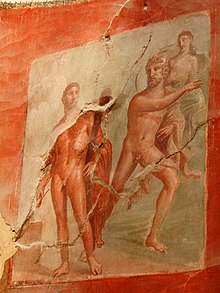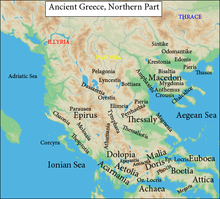|
Greek city of Oiniadai in Akarnania
Bronze 22mm (6.05 grams) Struck circa 219-211 B.C.
Reference: HGC 4, 899; Sear 2298 var.; BMC Central, pp. 189-190, nos. 6-14; BCD Akarnania 345-352
Laureate head of Zeus right.
OINIAΔAN, Bearded head of river-god Achelous right.
In the extreme south of the country, near the mouth of the Achelous, Oiniadai was close to the Aitolian border.
You are bidding on the exact item pictured, provided with a Certificate of Authenticity and Lifetime Guarantee of Authenticity.
In Greek mythology, Achelous was the patron deity of the “silver-swirling” Achelous River, which is the largest river of Greece, and thus the chief of all river deities, every river having its own river spirit. His name is pre-Greek, its meaning unknown. The Greeks invented etymologies to associate it with Greek word roots (one such popular etymology translates the name as “he who washes away care”). However, these are etymologically unsound and of much later origin than the name itself.

Achelous was often reduced to a bearded mask, an inspiration for the medieval Green Mann. Floor mosaic, Zeugma, Turkey.
Origin

Hercules and Achelous in a Roman wall painting from the Hall of the Augustales
Some Greek sources say that he was the son of Gaia and Oceanus; however, ancient Greeks generally believed with Hesiod that Tethys and Oceanus were the parents of all three thousand river gods. In the Renaissance, the improvisatory mythographer Natalis Comes made for his parents Gaia and Helios, Homer placed Achelous above all, the origin of all the world’s fresh water. By Roman times, Homer’s reference was interpreted as making Achelous “prince of rivers”.
Others derived the legends about Achelous from Egypt, and describe him as a second Nilus. But however this may be, he was from the earliest times considered to be a great divinity throughout Greece, and was invoked in prayers, sacrifices, on taking oaths, &c., and the oracular Zeus at Dodona usually added to each oracle he gave, the command to offer sacrifices to Achelous. This wide extent of the worship of Achelous also accounts for his being regarded as the representative of sweet water in general, that is, as the source of all nourishment.
Mythological tradition
Achelous was a suitor for Deianeira, daughter of Oeneus king of Calydon, but was defeated by Heracles, who wed her himself. Sophocles pictures a mortal woman’s terror at being courted by a chthonic river god:
- ‘My suitor was the river Achelóüs,
- who took three forms to ask me of my father:
- a rambling bull once, then a writhing snake
- of gleaming colors, then again a man
- with ox-like face: and from his beard’s dark shadows
- stream upon stream of water tumbled down.
- Such was my suitor.’ (Sophocles, Trachiniae, tr. Robert Torrance)

bronze coin struck in Oiniadai 219-211 BC depicting river-god Achelous as man-faced bull on reverse

The rivalry of Hercules and the river-god Achelous is depicted in this plaque by Annibale Fontana. The Walters Art Museum.
The contest of Achelous with Heracles was represented on the throne of Amyclae, and in the treasury of the Megarans at Olympia there was a statue of him made by Dontas of cedarwood and gold. On several coins of Acarnania the god is represented as a bull with the head of an old man.
The sacred bull, the serpent and the Minotaur are all creatures associated with the Earth goddess Gaia. Achelous was most often depicted as a gray-haired old man or a vigorous bearded man in his prime, with a horned head and a serpent-like body. When he battled Heracles over the river nymph Deianeira, Achelous turned himself into a bull. Heracles tore off one of his horns and forced the god to surrender. Achelous had to trade the goat horn of Amalthea to get it back. Heracles gave it to the Naiads, who transformed it into the cornucopia. Achelous relates the bitter episode afterwards to Theseus in Ovid‘s Metamorphoses. Sophocles makes Deianeira relate these occurrences in a somewhat different manner.
The mouth of the Achelous river was the spot where Alcmaeon finally found peace from the Erinyes. Achelous offered him Callirhoe, his daughter, in marriage if Alcmaeon would retrieve the clothing and jewelry his mother Eriphyle had been wearing when she sent her husband Amphiaraus to his death. Alcmaeon had to retrieve the clothes from King Phegeus, who sent his sons to kill Alcmaeon.

The Banquet of Achelous (ca. 1615), by Rubens
Ovid in his Metamorphoses provided a descriptive interlude when Theseus is the guest of Achelous, waiting for the river’s raging flood to subside: “He entered the dark building, made of spongy pumice, and rough tuff. The floor was moist with soft moss, and the ceiling banded with freshwater mussel and oyster shells.” In sixteenth-century Italy, an aspect of the revival of Antiquity was the desire to recreate Classical spaces as extensions of the revived villa. Ovid’s description of the cave of Achelous provided some specific inspiration to patrons in France as well as Italy for the Mannerist garden grotto, with its cool dampness, tuff vaulting and shellwork walls. The banquet served by Ovid’s Achelous offered a prototype for Italian midday feasts in the fountain-cooled shade of garden grottoes.
At the mouth of the Achelous River lie the Echinades Islands. According to Ovid’s pretty myth-making in the same Metamorphoses episode, the Echinades Islands were once five nymphs. Unfortunately for them, they forgot to honor Achelous in their festivities, and the god was so angry about this slight that he turned them into the islands.
Achelous was sometimes the father of the Sirens by Terpsichore, or in a later version, they are from the blood he shed where Heracles broke off his horn.
In another mythic context, the Achelous was said to be formed by the tears of Niobe, who fled to Mount Sipylus after the deaths of her husband and children.
In Hellenistic and Roman contexts, the river god was often reduced to a mask and used decoratively as an emblem of water, “his uncut hair wreathed with reeds”. The feature survived in Romanesque carved details and flowered duruing the Middle Ages as one of the Classical prototypes of the Green Man.
Achelous and the River Achelous
The origin of the river Achelous is thus described by Servius:
When Achelous on one occasion had lost his daughters, the Sirens, and in his grief invoked his mother Gaea, she received him to her bosom, and on the spot where she received him, she caused the river bearing his name to gush forth.
Other accounts about the origin of the river and its name are given by Stephanus of Byzantium, Strabo, and Plutarch. Strabo proposes a very ingenious interpretation of the legends about Achelous, all of which according to him arose from the nature of the river itself. It resembled a bull’s voice in the noise of the water; its windings and its reaches gave rise to the story about his forming himself into a serpent and about his horns; the formation of islands at the mouth of the river requires no explanation. His conquest by Heracles lastly refers to the embankments by which Heracles confined the river to its bed and thus gained large tracts of land for cultivation, which are expressed by the horn of plenty.
In the ancient Greek religion, Zeus was the “Father of Gods and men” (πατὴρ ἀνδρῶν τε θεῶν τε) who ruled the Olympians of Mount Olympus as a father ruled the family. He was the god of sky and thunder in Greek mythology. His Roman counterpart is Jupiter and Etruscan counterpart is Tinia.![The Jupiter de Smyrne, discovered in Smyrna in 1680[1]](https://upload.wikimedia.org/wikipedia/commons/thumb/c/c8/Jupiter_Smyrna_Louvre_Ma13.jpg/200px-Jupiter_Smyrna_Louvre_Ma13.jpg)
Zeus was the child of Cronus and Rhea, and the youngest of his siblings. In most traditions he was married to Hera, although, at the oracle of Dodona, his consort was Dione: according to the Iliad, he is the father of Aphrodite by Dione. He is known for his erotic escapades. These resulted in many godly and heroic offspring, including Athena, Apollo and Artemis, Hermes, Persephone (by Demeter), Dionysus, Perseus, Heracles, Helen of Troy, Minos, and the Muses (by Mnemosyne); by Hera, he is usually said to have fathered Ares, Hebe and Hephaestus.
Walter Burkert points out in his book, Greek Religion, “Even the gods who are not his natural children address him as Father, and all the gods rise in his presence.” For the Greeks, he was the King of the Gods, who oversaw the universe. As Pausanias observed, “That Zeus is king in heaven is a saying common to all men”. In Hesiod’s Theogony Zeus assigns the various gods their roles. In the Homeric Hymns he is referred to as the chieftain of the gods.
His symbols are the thunderbolt, eagle, bull, and oak. In addition to his Indo-European inheritance, the classical “cloud-gatherer” also derives certain iconographic traits from the cultures of the Ancient Near East, such as the scepter
Acarnania is a region of west-central Greece that lies along the Ionian Sea, west of Aetolia, with the Achelous River for a boundary, and north of the gulf of Calydon, which is the entrance to the Gulf of Corinth. Today it forms the western part of the regional unit of Aetolia-Acarnania. The capital and principal city in ancient times was Stratos. The north side of Acarnania of the Corinthian Gulf was considered part of the region of Epirus.
Acarnania’s foundation in Greek mythology was traditionally ascribed to Acarnan, son of Alcmaeon.

Ancient Greek Northern regions
History
Classical

Map of ancient Acarnania.
In the 7th century BC,[2] Greek influence in the region becomes prominent when Corinth settled Anactorium, Sollium and Leucas, and Kefalonia settled Astacus. Settlements in Alyzeia, Coronta, Limnaea, Medion, Oeniadae, Palaerus, Phytia and Stratus are also mentioned by Thucydides, this latter city being the seat of a loose confederation of Acarnanian powers that was maintained until the late 1st century BC.
Because it is located strategically on the maritime route to Italy, Acarnania was emmired in many wars. In 5th century BC, the Corinthians were forced out of their Acarnanian settlements by Athens. In 4th century BC, c. 390 BC, the cities of Acarnania surrendered to the Spartans under King Agesilaus, and continued to be Spartan allies until joining the Second Athenian Empire in 375 BC. The Acarnanians later sided with Boeotia in their fight against Sparta, and with Athens against Philip II of Macedon at Chaeronea.
Acarnania thereafter came under Macedonian rule. In 314 BC, at the behest of Macedonian king Cassander, the settlements of Acarnania lying near the Aetolian border were conglomerated into fewer, larger settlements. Still, border conflicts with the Aetolians were frequent, and led to Acarnania’s territory being partitioned between Aetolia and Epirus, c. 250 BC. After the fall of the king of Epirus, the Acarnanian territory that had been given to Epirus regained its independence, and gained Leucas from Epirus, which became the capital of the region.
Acarnania allied itself with Philip V of Macedon against Rome in 200 BC, although it lost Leucas because of this, and the city of Thyrreion was anointed the new capital.
In the 1st century BC, Acarnania suffered greatly at the hands of pirates, and in Rome’s civil wars. Afterwards, the towns and settlements of Acarnania fell under the rule of Nicopolis.
Byzantine
Main article: Nicopolis (theme)
When the Byzantine Empire broke up (1204), Acarnania passed to the Despotate of Epirus and in 1348 it was conquered by Serbia. Then in 1480 it fell to the Ottoman Empire. Since 1832 it has been part of Greece.
Modern
Main article: Aetolia-Acarnania
Geography
Acarnania is composed of three main regions: 1) a rocky coastline, 2) a rugged strip of mountain range that follows the coastline, and 3) plains lying between these mountains and the Achelous River.
|










![The Jupiter de Smyrne, discovered in Smyrna in 1680[1]](https://upload.wikimedia.org/wikipedia/commons/thumb/c/c8/Jupiter_Smyrna_Louvre_Ma13.jpg/200px-Jupiter_Smyrna_Louvre_Ma13.jpg)





